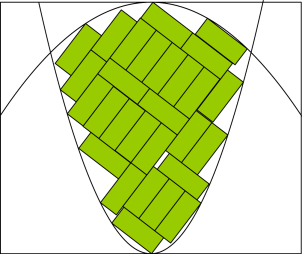Orthogonal packing of rectangles
within isotropic convex regions
This Web site provides additional material to the paper
E. G. Birgin and R. D. Lobato. Orthogonal packing of identical rectangles within isotropic convex regions. Computers & Industrial Engineering (2010) 59, 595–602.
The full text is locally available in PDF
and PS formats. The full text can also be found
at ScienceDirect.
The computer implementation in Fortran 77/95 is available
to download under the
terms of the GNU General
Public License.
Below you can find instructions on how to compile and run the program,
visualize the solution, and modify the program in order to solve your
own instance of the problem. If you have any questions, please send an
e-mail to rafael@lobato.it.
Compiling and running it
To compile the program, just type
./compile.shTo run it, type
./igenpackThe program will ask you which problem you would like to solve (choose a number between 1 and 16 to solve one of the 16 problems presented in the paper) and the minimum and maximum number of rectangles the method will try to pack.
The program will output the number of rectangles that have been packed until the upper bound is reached.
Graphical representation of the solution

To generate the graphical representation of the solution, first
compile
the MetaPost
file solution.mp, which was created by
IAlgencan, by typing
mpost solution.mp
It will generate a file called solution.1. Then, to
create
a PostScript
file, just type
latex solution.texand then
dvips solution.dvi -o solution.ps
The PostScript file with the graphical representation of the solution
will be in the file called solution.ps.
To see this file, type, for example,
gv solution.psSolving your own problem
To solve your own instance of the problem, you just need a basic
knowledge of Fortran 77/95 programming language to edit the
file Packing.f95.
In this file you will need add the information of your problem in
the following subroutines:
-
DEFPROis the subroutine that defines some information of the problem.Rectangular item information
dx: half of the horizontal side of the rectangles
dy: half of the vertical side of the rectanglesBox constraints of the convex region
lx: lower bound for the x-axis
ux: upper bound for the x-axis
ly: lower bound for the y-axis
uy: upper bound for the y-axisExtra-information of the convex region
The following four parameters must represent a limited box that contains the convex region. See, for example, problems 4, 5, 6 and 11 that have their boxes (which are not part of the definition of the convex region) drawn in Figure 2 of the paper. You can see that these boxes do not take part in the definition of the convex regions in Table 1 of the paper.
xmin: containing-box lower bound for the x-axis
xmax: containing-box upper bound for the y-axis
ymin: containing-box lower bound for the x-axis
ymax: containing-box upper bound for the y-axisMore information of the convex region
r: number of smooth functions in the definition of the convex region -
EVALWis the subroutine that implements the smooth functions that define the convex region. -
EVALDWis the subroutine that computes the derivatives of the smooth functions that define the convex region. -
DRAWSOLis the subroutine that draws the graphical representation of the solution. The piece of code that draws the packed items is common to all the problems and you do not need to modify it. You just need to add the piece of code that draws the convex region. If you are not interested in the graphical representation of the solution, you may skip this subroutine.
After having modified the four subroutines, just compile the program and run it as explained above.
Sponsor
This work was partially supported by the Brazilian agency FAPESP (Fundação de Amparo à Pesquisa do Estado de São Paulo).